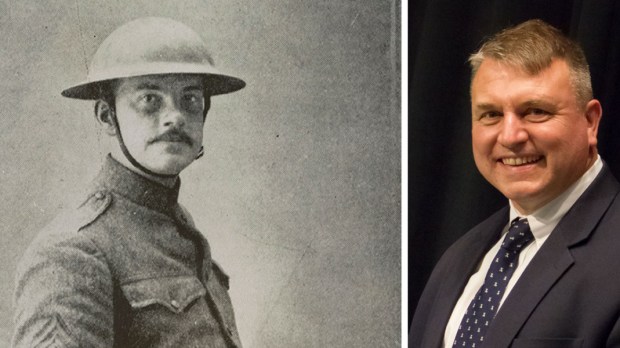In the months before the end of the First World War, two of the period’s best-known British poets met in Scotland. They were both soldiers in the war, and were recovering from their experiences in a hospital in Edinburgh.
This week, they will meet again on a stage in New York City, when a theater piece by literary biographer Joseph Pearce premieres at the Sheen Center. Death Comes for the War Poets explores the interaction between the poets, Wilfred Owen and Siegfried Sassoon, and a third character, Death.
Owen may be known best for the poem “Dulcem et Decorum Est.” Sassoon later won acclaim for his prose work, notably his three-volume fictionalized autobiography, the “Sherston trilogy.”
Owen was a patient in Craiglockhart War Hospital because he suffered from PTSD, known at the time as “shell shock.” While serving in France, he had been blown up by a trench mortar and spent several days unconscious on an embankment lying among the remains of one of his fellow officers.
Sassoon, who had served on the Western Front, was in Craiglockhart because he had made a public declaration against the war. He could have been court-martialed, but he was declared to be suffering from shell shock and committed to the mental hospital.
While in Edinburgh, the two poets became close friends. Sassoon’s influence can be seen in the poetry Owen subsequently wrote. Sassoon implored Owen not to return to the battlefield after his convalescence, but the younger man “felt he had a duty to go back and witness, to be with his comrades,” Pearce said.
Owen was killed in action on November 4, 1918, a week before the signing of the Armistice which ended the war.
In addition to being one of the deadliest wars in history, World War I “destroyed the poetry of war glorified,” Pearce said in a recent lecture at the Knights of Columbus Museum, which has an exhibit to mark the centenary of the United States’ entry into the war. “Before that, you had to see the whites of your enemy’s eyes. There was real courage involved. World War I was the first war of the machine, where men were obliterated by machines, and you didn’t even have to see who they were. So no more poems like Tennyson’s ‘Charge of the Light Brigade.’ Chesterton’s ‘Lepanto’ came out just before World War I. It was much easier to write about war glorified in 1911 than 10 years later, because of what happened in between.”
The subject matter of Sassoon’s own poetry shows a definite change between the “young man singing about milkmaids or sunrises” before 1914 and the horrors of the trenches in later works.
The rest of his life shows an evolution as well. While Owen’s life was cut short in 1918, Sassoon lived until 1967, giving him plenty of opportunity to reflect on the irony that the conflict he participated in was supposed to be the “war to end all wars.” He lived to see its continuation in World War II, culminating in the atomic bombing of Japan.
As the promotional material for Pearce’s theater piece says, Death Comes for the War Poets asks the question, “How does one cope with the horror of war? Is there room for hope? And what of the Spirit of Death? Can Death itself be changed?”
Pearce is known for his writing and speaking about Shakespeare and a host of literary figures who became Catholic, but this is his first venture into the theater.
“It’s always been in the back of my mind to write a biography of [Sassoon],” he said in an interview, saying he discovered that so much of his poetry could be pieced together into a kind of “autobiography.”
“But then I had this sort of vision of doing it as a verse drama, and that sort of came to me—there’s no other word to describe it but a eureka moment, and the actual work was done in one night,” Pearce said. “I went back and tweaked it and tweaked it a bit as we had rehearsals as well. But literally most of it came as a gift.”
He approached Dominican Father Peter John Cameron, editor of Magnificat and a playwright himself. Father Cameron agreed to produce the play.
“What struck me when Joseph proposed this to me was sort of the courage with which a poet is going to look face to face with one of the worst experiences of evil the planet has ever faced, which is this horrific war, where not only were millions of men killed but they were killed sometimes in the most gruesome sort of way,” Father Cameron said in an interview. “Even in subsequent wars where also an ungodly number of people were killed, it was not in this sort of gruesome, very personal sort of way. So for these poets to take that on and to try to make sense of it is, I think, a very gutsy, daring thing to do. And with a conclusion that does not lead to despair or despondency or anything dark, especially in the case of Siegfried Sassoon, who went on to convert to Catholicism and live a kind of transfigured life as a result of his faith.”
Death Comes for the War Poets stars Nicholas Carriere, Sarah Naughton, and Michael Raver. It is directed by Peter Dobbins. It opens at the Sheen Center for Thought and Culture in Manhattan on Friday, June 9, at 7:30 p.m., and runs through June 24. The evening before, June 8, Pearce and Father Cameron will take part in a conversation about the play at 7 pm. Tickets are $25.

